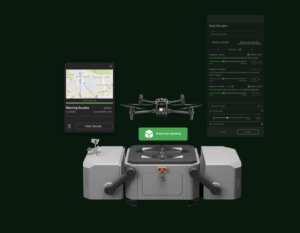 At DJI AirWorks today, FlytBase Director of Business Development discussed 5 steps to ensuring that enterprise companies are ready to apply for permission to fly automated BVLOS operations with a docking station.
At DJI AirWorks today, FlytBase Director of Business Development discussed 5 steps to ensuring that enterprise companies are ready to apply for permission to fly automated BVLOS operations with a docking station.
FlytBase provides the FlytNow cloud-based software for the automation of routine missions using docking stations – a box. that houses the drone, charges the battery, and monitors conditions. FlytBase has partnered with 15 different drone-in-a-box companies, and support 17 different docking solutions.
“5 years ago, you needed a pilot, an observer, a drone maintenance person to swap batteries – now there can be nothing but a box, anywhere in the world, thousands of miles away from your control rooms. And all over the world, people are deploying these systems,” says FlytBase CEO and Founder Nitil Gupta.
Gupta and his colleague Achal Negi, FlytBase Director of Business Development, say that getting approvals or waivers is very possible – but requires planning nad consideration to ensure that companies have the right match between use case and hardware and are prepared to demonstrate their risk mitigation strategies.
Achal Negi Describes 5 Steps to Prepare for Automated BVLOS Flight with Docking Stations
- Determine the Use Case. Automated BVLOS flights with docking stations are most appropriate for a use case that requires really frequent operations, high frequency missions, or immediate response. “That’s when it’s too expensive to have a pilot on site for every flight,” says Negi. Construction site management, security patrols, solar panel inspection, power plant inspection, Smart City, Emergency Response, Railway Yards Inspection, or Traffic Management are all great use cases for docking stations. “If you are flying every day, that’s when you need a docking system,” he says.
- Select appropriate Hardware. It’s important for companies to match the right drone – and the right docking station – to the job. What camera is required? How robust does the platform need to be? Do you need battery charging, or battery swapping capabilities that would allow the drone to immediately return to the air?
- Setup RDOC – the Management System, and Risk Mitigations. RDOC is what FlytBase provides, and they’ve helped many of their customers get waivers or permissions for automated BVLOS flight. That’s because the right RDOC can demonstrate the risk mitigation that authorities need to see. Both drones and docking stations need to be monitored from the control center. Operators must be able to monitor the HVAC system so that batteries are protected, monitor the weather data, and more. Additionally, the software needs to manage every scenario – and be adaptable to different aircraft in different situations. For example, docking stations with non-weather resistant drones can be programmed not to open during a weather event: those carrying more robust airframes can allow flight. There’s a lot to think about, and the software should help with all aspects of risk mitigation and have the failsafes that deal with any potential problems, including battery failure, Internet failure, or the failure of the docking station itself. FlytBase works on BVLOS flight in 5 different countries, and has a different suite of capabilities based on each country’s requirements.
- Apps and Inteegration. The drone and the dock are just part of the solution that regulators need to see to approve BVLOS ops. In some cases, operations may require a parachute, sense and avoid capabilities, and integration with Unmanned Traffic Management (UTM) systems. For some use cases, the solution may need to integrate with external alarm systems, triggering a drone to respond to a certain area – for example, if a security system is breached, the drone may need to immediately respond to the location of the breach to deliver situational awareness.
- Scale and Multiple Deployments. Finally, says Negi, enterprise companies must plan ahead for scale and multiple deployments – demonstrating that they will be able to monitor and manage all of their systems and field operations.
Automation has been a major theme in the drone industry for several years now. BVLOS regulations in the US have still not been regularized, but it is getting easier to get permissions as the software and docking stations become ever more sophisticated. Automated BVLOS flight, however, has such a high ROI to offer for enterprise that companies like BNSF Railway are willing to do the hard work of collaborating with regulators and manufacturers to develop drone and docking solutions.
Read more about FlytBase:
- FlytBase Enhances Drone Software with FlytNow Upgrades
- Simplifying Drone Operations for Enterprise Customers: DroneLogbook and FlytBase
- Precision Landing for DJI Drones: New Automation Solution from FlytBase
- FlytBase Shows Remote Drone Operations Software with BVLOS capability at AUVSI

Miriam McNabb is the Editor-in-Chief of DRONELIFE and CEO of JobForDrones, a professional drone services marketplace, and a fascinated observer of the emerging drone industry and the regulatory environment for drones. Miriam has penned over 3,000 articles focused on the commercial drone space and is an international speaker and recognized figure in the industry. Miriam has a degree from the University of Chicago and over 20 years of experience in high tech sales and marketing for new technologies.
For drone industry consulting or writing, Email Miriam.
TWITTER:@spaldingbarker
Subscribe to DroneLife here.







[…] [3] Automated BVLOS Flight and Docking Stations – Dronelife https://dronelife.com/2022/10/11/5-steps-to-getting-started-with-automated-bvlos-and-docking-station… […]